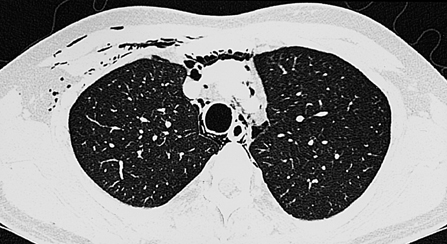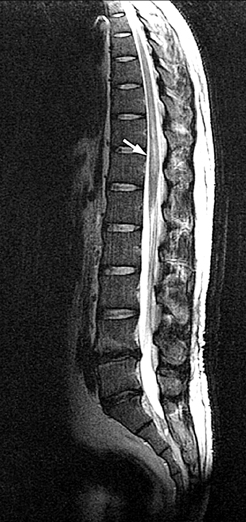Yonsei Med J.
2005 Apr;46(2):292-295. 10.3349/ymj.2005.46.2.292.
Pneumomediastinum Due to Intractable Hiccup as the Presenting Symptom of Multiple Sclerosis
- Affiliations
-
- 1Department of Neurology, Yonsei University College of Medicine, Seoul, Korea. kylee@yumc.yonsei.ac.kr
- 2Department of Internal Medicine, Yonsei University College of Medicine, Seoul, Korea.
- 3Department of Diagnostic Radiology, Yonsei University College of Medicine, Seoul, Korea.
- KMID: 1734058
- DOI: http://doi.org/10.3349/ymj.2005.46.2.292
Abstract
- Pneumomediastinum and subcutaneous emphysema generally occurs following trauma to the esophagus or lung. It also occurs spontaneously in such situations of elevating intra- thoracic pressure as asthma, excessive coughing or forceful straining. We report here on the rare case of a man who experienced the signs of pneumomediastinum and subcutaneous emphysema after a prolonged bout of intractable hiccup as the initial presenting symptoms of multiple sclerosis.
MeSH Terms
Figure
Reference
-
1. Souadjian JV, Cain JC. Intractable hiccup: etiologic factors in 220 cases. Postgrad Med. 1968. 43:72–77.2. Marsot-Dupuch K, Bousson V, Cabane J, Tubiana JM. Intractable hiccups: the role of cerebral MR in cases without systemic cause. AJNR Am J Neuroradiol. 1995. 16:2093–2100.3. Nathan MD, Leshner RT, Keller AP Jr. Intractable hiccups (singultus). Laryngoscope. 1980. 90:1612–1618.4. Koullias GJ, Korkolis DP, Wang XJ, Hammond GL. Current assessment and management of spontaneous pneumomediastinum: experience in 24 adult patients. Eur J Cardiothorac Surg. 2004. 25:852–855.5. Jougon JB, Ballester M, Delcambre F, Mac Bride T, Dromer CE, Velly JF. Assessment of spontaneous pneumomediastinum: experience with 12 patients. Ann Thorac Surg. 2003. 75:1711–1714.6. Park KW, Cheon SM, Hong SK, Choi SH, Cha JK. A case of intractable hiccups as presenting symptom of multiple sclerosis. J Korean Neurol Assoc. 2002. 20:195–198.7. Funakawa I, Terao A. Intractable hiccups and syncope in multiple sclerosis. Acta Neurol Scand. 1998. 98:136–139.8. Chang YY, Wu HS, Tsai TC, Liu JS. Intractable hiccup due to multiple sclerosis: MR imaging of medullary plaque. Can J Neurol Sci. 1994. 21:271–272.9. Funakawa I, Hara K, Yasuda T, Terao A. Intractable hiccups and sleep apnea syndrome in multiple sclerosis: report of two cases. Acta Neurol Scand. 1993. 88:401–405.10. McFarling DA, Susac JO. Hoquet diabolique: intractable hiccups as a manifestation of multiple sclerosis. Neurology. 1979. 29:797–801.11. Al Deeb SM, Sharif H, Al Moutaery K, Biary N. Intractable hiccup induced by brain stem lesion. J Neurol Sci. 1991. 103:144–150.
- Full Text Links
- Actions
-
Cited
- CITED
-
- Close
- Share
- Similar articles
-
- A Case of Intractable Hiccups as Presenting Symptom of Multiple Sclerosis
- A Case of Intractable Hiccup in Multiple Sclerosis
- Treatment of Postoperative Intractable Hiccup Patient with Unilateral Phrenic Nerve Block: A case report
- Intractable Hiccup Induced by Multiple Cerebral Infarct: A case report
- Intractable Hiccup as the Presenting Symptom of Cavernous Hemangioma in the Medulla Oblongata: A Case Report and Literature Review




